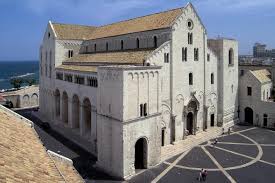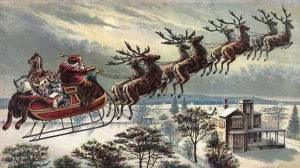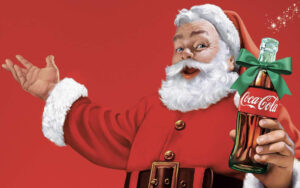Saint Nicholas’ Last Days in the East
For many centuries Nicholas’ burial place at Myra was a pilgrimage center. However, as time went on, the eastern Mediterranean became a Muslim sea with many pirates, unsafe for travelers. Fewer and fewer came to visit. Then an earthquake devastated Myra leaving the shrine in ruins, his vault nearly buried. (We have at our church some stones from the ruins of the old Saint Nicholas Cathedral, Myra. Did Saint Nicholas himself walk on them? by them?)
First, Saint Nicholas’ relics get stolen
In the year 1087 a ship of merchants from Bari in southern Italy came and, well…, stole his body and took it home. They said that they had had a vision of Nicholas begging them to rescue him from the Muslims. According to the account, the Christians of Myra put up no objection. I doubt that. My guess is that these merchants, like all their kind, knew a good moneymaking venture when they saw it. Ever since, Nicholas’ body has lain in San Nikola Basilica in Bari (see Blog post 18) which drew and still draws many pilgrims, with merchants still making money off the pilgrims. Eastern bishops did not object overmuch to Nicholas going to Italy, since this was before the division between East and West, and Southern Italy was still culturally Greek and ecclesiastically Orthodox at this point. The result has been that our Bishop Nicholas wound up in Roman Catholic hands. However, there is
(see Blog post 18) which drew and still draws many pilgrims, with merchants still making money off the pilgrims. Eastern bishops did not object overmuch to Nicholas going to Italy, since this was before the division between East and West, and Southern Italy was still culturally Greek and ecclesiastically Orthodox at this point. The result has been that our Bishop Nicholas wound up in Roman Catholic hands. However, there is  now an Orthodox chapel next to his resting place in the Basilica, and Orthodox Divine Liturgies are celebrated there regularly. God bless the Roman Catholic Bishop of Bari.
now an Orthodox chapel next to his resting place in the Basilica, and Orthodox Divine Liturgies are celebrated there regularly. God bless the Roman Catholic Bishop of Bari.
Myrrh still flows from his body. On the two annual feasts of Saint Nicholas (December 6 and May 9, the day of his “translation” to Bari) a priest opens his tomb and gathers myrrh, which is then distributed… for a price. His body, I read, is still in fairly good condition for a man 13 centuries old. Some years ago the Roman Catholic Church felt compelled to have a scientific analysis. (I think we Orthodox wouldn’t do that. We have hundreds of weeping icons whose myrrh has never seen the inside of a chem lab.) They discovered that the “myrrh”, whatever it is, has little or no bacterial content. Small relics of Saint Nicholas are also distributed through the world, one of which is encased in the altar of our Saint Nicholas Church. Thus we who live 5000 miles and 17 centuries removed from the time of Bishop Nicholas have a physical connection with our patron.

Next, Saint Nicholas’ personality gets stolen
How was Saint Nicholas transmogrified * into modern Santa Claus? Here’s the strange story as best I can put it together.
* Yes, this is a real word! I first learned it from the the old cartoon “Calvin and Hobbes”! It means “to change or alter greatly, often for grotesque or humorous effect”, which certainly fits the case here.
In Orthodox and other Mediterranean lands, so far as I can determine, Saint Nicholas has remained Saint Nicholas. However in northern Europe legends and myths began to develop about him – maybe because during most of the Middle Ages people there were largely uneducated.

If you’ve ever studied mythology, you know once myths gets started they just grow, and there’s no stopping them. And so they did. For example my grandfather whose family came from southern Germany called Saint Nicholas “Pelznickel” or “Belznickel” (literally “rod nicholas”). In south German mythology this was a fur-clad old man who carried a rod or switch and on the eve of December 6 brought good boys and girls a gift – with any luck an orange which was a great delicacy. But bad children were said to get a smack with the rod. However, my father thought it was Saint Nicholas who came visiting, accompanied by a little imp called Black Peter who brought a lump of coal to bad children. And so it went on in a quiet harmless way.
Something at this time of year seems to require gift-giving. (The return of the sun? which is well worth celebrating.) In Greece, for example, Saint Basil give gifts on Saint Basil’s Day, January 1. After the Reformation saints were ignored in Protestant lands, but often they continued in disguise. In the Low Countries now it was Sinter Klaas (say “Sinter Klaas” 3 times fast) who brought gifts. In England “Father Christmas” still brings presents at Christmas. But little of this was connected directly with Saint Nicholas.
Santa Claus arrives

However, in America Saint Nicholas was entirely transformed. In the 1830s Clement Clarke Moore, a professor at my old Episcopal Seminary in New York, wrote a poem for his children called “A Visit from Saint Nicholas”. In it (for reasons God only knows – Moore never explained) he turned our holy bishop into a “jolly old [Norse] elf” who lived at the North Pole, flew through the air in a sleigh powered by “eight tiny reindeer” (Rudolph was a 20th century invention) Christmas. Because the poem was so charming it became immensely popular and remains so – but it has nearly destroyed the popular image of Saint Nicholas as a holy bishop.
As I said, myths grow and develop, and this one has grown like crazy, and in America during the 19th century Saint Nicholas the elf mutated into our modern Santa Claus.
Clement Clarke Moore lived in New York City, originally New Amsterdam, where Dutch tradition was still strong. So Saint Nicholas became the Dutch Sinter Klaas, and then “Santa Claus”, and by the end of the century he had grown into a full-sized fat jolly old man.


“The business of America is business”, so by the early twentieth century, American commercial interests saw an opportunity.. Santa Claus began to appear in advertisements selling Coca Cola and what not, and he soon became the promoter of American Christmastime consumerism. He still retained an air of mystery. However, with the advent of popular television about the year 1950, it all began to go crazy. He appeared in multiple TV commercials, often wearing an obviously fake beard. And as commercial interests have pushed the shopping season earlier and earlier, today we find Santa and sometimes Mrs. Claus arriving by helicopter in mid November and then he appears all over the place selling autos and toothpaste.. and… well, I found him on YouTube selling sex toys. (For your own peace of mind, don’t look it up!) In his oddest recent Milwaukee manifestations 1) I saw him on a street corner recently holding up a sign “BUY ONE GET ONE FREE” and 2) this December Santa has been hearing children’s requests in the main building of a large local “commercial minded” cemetery! Future archaeologists, studying the remains of our culture, will wonder what in the world this was all about. Was he a myth or did people really believe in this odd seasonal god? And why did they pay so much more attention to him than to Jesus whose birth they were presumably celebrating?
American Santa Claus has now gone abroad. I read about an American visiting Germany who was taken by a German friend to a Saint Nicholas Cathedral, and assuming Americans didn’t know about Saint Nicholas (he was probably right) said, “Saint Nicholas. You know, Santa Claus”. In Myra, where till recently there stood a respectable statue of Saint Nicholas. Look what they’ve replaced him with:
By the way, if you want extreme mythological fusion, I read about a plastic Santa Claus in Greece who, if you pulled the string on his back, said “Ho! Ho! Ho! Saint Basil is coming!”
His outfit still shows it’s episcopal origins: a red hat sort of like a droopy western mitre, white beard, red “vestments” (for Orthodox Advent?).
But oh! what have they done to our dear blessed Bishop Saint Nicholas?!

I’ve come to think of modern Santa Claus as Saint Nicholas’ kind of off-the-wall nephew – you know, the one you’d prefer to hide away somewhere and and let him out in publoc only once in a while.
What’s good about Santa Claus
Don’t get me wrong here: I do not intend to be the Grinch. Parents, please don’t destroy little children’s belief in Santa Claus – as if we could! That would be cruel. At least as I remember it from when I was a boy, it can develop in children a healthy sense of mystery and wonder. When I was 6 or 7 I asked my mother “How long has Santa Claus been around?” She responded “Forever, I guess”, and for the first time I caught a glimmering of “eternity”. Have you ever seen the 1947 movie or read the book Miracle on 34th Street? about an old man named Kris Kringle who thinks he really is Santa Claus, and while playing (no, “being”) Santa Claus at Macy’s quietly reverses the American commercial spirit, and by the end you wonder…well, see it or read it for yourself. A sweet book, with no overt Christian connections, but it’s filled with joy and wonder. I loved to read it when I was a boy; I still do. It captures the mystery of Santa Claus and Christmas as it was then – in those old days before children could see Santa twenty times a day on TV.
All I ask is that we don’t confuse Santa Claus with Saint Nicholas. Parents, go out of our way to teach our children about the true Saint Nicholas. Here’s how my wife and I handled it with our kids, 45 years ago. When they asked about Santa Claus we answered “What do you think?”, which saved us from lying, and allowed them to think it through and be proud of themselves when they figured it out. We still put out presents on Christmas night to be opened in the morning.

But also on Saint Nicholas Eve, following family custom, we hung up their stockings, and using realistic stick figures Saint Nicholas appeared from behind the sofa (dressed as a Western Bishop, since we were not Orthodox then) promising a present the next morning. Black Peter * then emerged accusing them of being bad. Saint Nicholas defended them, and sure enough in the morning…
- Only his clothing wss black. That was almost fifty years ago. Were it today I think we’d use Pelznickel here as the bad guy.
They knew all this was play-acting, but then we’d tell them the true story of good Saint Nicholas the bishop. Parents, you can do something like that. Be inventive. At Saint Nicholas Orthodox Church, it’s much easier: we talk about his icon and all the good things he has done for us and for everyone.
Saint Nicholas begins to escape
Have you noticed that only rarely do we hear Santa Claus called “Saint Nicholas” any more, as he was when I was young. Hooray! In America today I don’t think one person in a thousand would automatically identify our commercial Santa Claus with Bishop Saint Nicholas. I think this means he is escaping from the myth people have created for him. And I think we can help him. Tell the story of good Bishop Nicholas – with your children, with non-Orthodox and even uneducated Orthodox, as you have opportunity. Spread devotion to Saint Nicholas of Myra, the Wonderworker. Help him to escape from his ridiculous man-made prison of “Ho! Ho! Ho! Buy a Mercedes!” Or worse.
Dear holy Bishop Nicholas, pray for us.
Next Week: January 1 – Saint Basil, Civil New Year
And then: On the Road again after all this time – Greece
____________________________________
In this article above I complained much about what’s happened to Saint Nicholas in the West. Please remember that much in Western Christianity is good and holy and beautiful. For example, from my Anglican heritage, here is the lovely service of Christmas Lessons and Carols, both ancient and modern, from King’s College, Cambridge. With this, I wish to you and your loved ones a blessed and holy feast of the Nativity of our Lord, God and Savior, Jesus Christ.
Please note that you need to switch to YouTube to hear it.